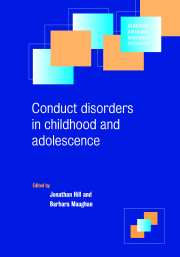Book contents
- Frontmatter
- Contents
- List of contributors
- Preface
- 1 Bad behaviour: an historical perspective on disorders of conduct
- 2 Can the study of ‘normal’ behaviour contribute to an understanding of conduct disorder?
- 3 The development of children's conflict and prosocial behaviour: lessons from research on social understanding and gender
- 4 Neural mechanisms underlying aggressive behaviour
- 5 Biosocial influences on antisocial behaviours in childhood and adolescence
- 6 The epidemiology of disorders of conduct: nosological issues and comorbidity
- 7 Conduct disorder in context
- 8 Genetic influences on conduct disorder
- 9 The role of neuropsychological deficits in conduct disorders
- 10 A reinforcement model of conduct problems in children and adolescents: advances in theory and intervention
- 11 Perceptual and attributional processes in aggression and conduct problems
- 12 Attachment and conduct disorder
- 13 Friends, friendships and conduct disorders
- 14 Continuities and discontinuities of development, with particular emphasis on emotional and cognitive components of disruptive behaviour
- 15 Treatment of conduct disorders
- 16 The prevention of conduct disorder: a review of successful and unsuccessful experiments
- 17 Economic evaluation and conduct disorders
- 18 Antisocial children grown up
- 19 Conduct disorder: future directions. An afterword
- Index
14 - Continuities and discontinuities of development, with particular emphasis on emotional and cognitive components of disruptive behaviour
Published online by Cambridge University Press: 11 August 2009
- Frontmatter
- Contents
- List of contributors
- Preface
- 1 Bad behaviour: an historical perspective on disorders of conduct
- 2 Can the study of ‘normal’ behaviour contribute to an understanding of conduct disorder?
- 3 The development of children's conflict and prosocial behaviour: lessons from research on social understanding and gender
- 4 Neural mechanisms underlying aggressive behaviour
- 5 Biosocial influences on antisocial behaviours in childhood and adolescence
- 6 The epidemiology of disorders of conduct: nosological issues and comorbidity
- 7 Conduct disorder in context
- 8 Genetic influences on conduct disorder
- 9 The role of neuropsychological deficits in conduct disorders
- 10 A reinforcement model of conduct problems in children and adolescents: advances in theory and intervention
- 11 Perceptual and attributional processes in aggression and conduct problems
- 12 Attachment and conduct disorder
- 13 Friends, friendships and conduct disorders
- 14 Continuities and discontinuities of development, with particular emphasis on emotional and cognitive components of disruptive behaviour
- 15 Treatment of conduct disorders
- 16 The prevention of conduct disorder: a review of successful and unsuccessful experiments
- 17 Economic evaluation and conduct disorders
- 18 Antisocial children grown up
- 19 Conduct disorder: future directions. An afterword
- Index
Summary
This chapter concerns continuities and discontinuities in disruptive behaviour disorder, including oppositional defiant disorder (ODD) and conduct disorder (CD). It takes as its starting point a series of reviews on the stability of disruptive behaviour (Caspi & Moffitt, 1995; Coie & Dodge, 1998; J.D. Hawkins et al., 1998; Lahey et al., 1992, 1997; Lipsey & Derzon, 1998; Loeber, 1982, 1991; Loeber & Dishion, 1983; Loeber & Stouthamer-Loeber, 1987; Maughan & Rutter, 1998) showing quite high continuities between childhood, adolescent and adult manifestations of disruptive behaviours, including delinquency and antisocial personality disorder. This chapter expands the prior reviews by addressing the following questions:
What are some of the main findings on the prediction of disruptive behaviour, and what are the caveats to be kept in mind when interpreting figures on the continuity of disruptive behaviour?
Why is it important to understand heterotypic continuity of disruptive behaviour?
What are psychiatric models of continuity and escalation in disruptive behaviour?
Are there multiple pathways to serious symptoms of disruptive behaviour?
What are the emotional and cognitive factors that are thought to influence the stability of disruptive behaviour?
It should be understood that there are many different factors that influence the continuity of disruptive behaviour. In this volume, neurochemistry and brain factors are reviewed by Herbert & Martinez (chapter 4), genetic factors by Simonoff (chapter 8), environmental influences by Maughan (chapter 7) and neuropsychological aspects are reviewed by Lynam & Henry (chapter 9).
Keywords
- Type
- Chapter
- Information
- Conduct Disorders in Childhood and Adolescence , pp. 379 - 407Publisher: Cambridge University PressPrint publication year: 2000
- 2
- Cited by

